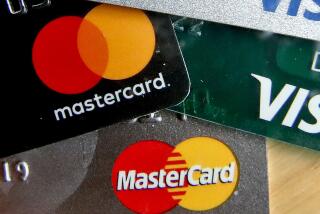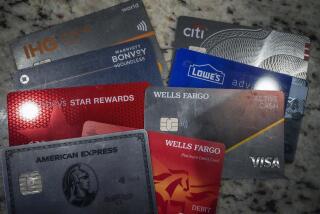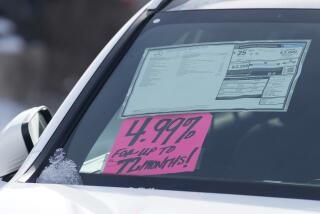Pressure Builds to Lower Rates on Credit Cards
WASHINGTON â For the credit card industry, 1986 has been a premium year. Pretax profits are estimated at $5 billion, up from $3.6 billion in 1985, according to H. Spencer Nilson, publisher of the authoritative Nilson Report.
Unfortunately for the industry, the record appears destined to stand for a long time to come.
âThis is the most profitable year,â Nilson said. âIt will never be this profitable again.â
Banks--some of which made 30% of their total profits from credit card operations--are increasingly feeling the pressures of lower interest rates and greater competition.
A year of concerted lobbying by consumer groups and congressmen to get card issuers to cut rates has begun to pay off. Although the average rate charged on bank cards has declined by less than a point to 18.15%, the momentum may finally be there.
Two weeks ago, the third-largest issuer, Chase Manhattan with 4.2 million accounts, lowered its rate on its regular Visa and Mastercard to 17.5% from 19.8%. The rate on its premium Visa card went to 16.5%.
âChase anticipates that Citibank will lower rates on its standard cards and wanted to get there ahead,â Nilson said. Citibank, the foremost issuer with 7 million accounts, lowered the interest rates on its preferred Visa to 16.8% several weeks ago.
âBegun to Crackâ
âThe bank card market has begun to crack,â said Rep. Charles E. Schumer (D-N.Y.), who has been a protagonist in the struggle for lower rates.
âWith Chaseâs decision to lower its rate . . . the crack has become a stream and soon it will become a torrent,â Schumer said. âI believe the same thing can happen with department store credit card rates.â
He recently issued a list of rates on charge cards issued by the largest department stores in the country. The average annual interest rate charged by the 12 biggest was 19.9%.
Heading the list were Hechtâs, based in Virginia; Higbees, headquartered in Ohio, and the Montgomery Ward, Marshall Field and Carson Pirie Scott chains, all based in Illinois. Schumer urged shoppers to take out personal bank loans, whose rates run around 14.7%, rather than pay the store rates.
Hechtâs vice president for finance, Tom Singleton, defended the 21.6% rate by pointing out that stores, unlike banks, do not charge annual fees. He said the ratio of in-house cards to Visas and Mastercards used by Hechtâs customers is two or three to one, an indication that rate sensitivity is not strong among them.
Interested in Rates
Elgie Holstein, director of Bankcard Holders of America, said calls to his organization show that two-thirds of consumers are interested in rates. Chase hopes that lower rates, as part of a package of enhancements and fee waivers, will lure 1.5 million new cardholders.
But Nilson countered that fewer than 5% of cardholders shift cards because of rates on carrying charges. As for Chaseâs 10% travel rebates on hotels and 5% on air fares and car rentals, Nilson dismisses them as a marketing ploy.
âEnhancements are a bunch of junk; most of them are never used,â he said.
American Express disagrees. In announcing recently an extension of its manufacturersâ warranty for products purchased with its card, President Ed Cooperman called it âone of the most popular programs ever among our card members.â
Chase announced it would waive its annual $20 fee on its regular card if the holder charged $2,400 worth of goods and services each year; the $45 fee for a premium card would be waived after $5,000 in annual purchases.
In a different twist, Bank of Virginia has scaled the interest rate to the balance: The higher the outstanding monthly balance, the lower the rate.
Bucking the Tide
By offering to eliminate annual fees, Chase is in one sense bucking the tide of rising fees accompanying lower rates. On the other hand, it is following the trend toward more use of lucrative cash advances, Nilson said. It raised the fee on cash advances from 50 cents per transaction to 2% of the total value, with a maximum of $10.
These transactions, which incur interest charges immediately since there is no grace period, can constitute up to 20% of small banksâ accounts outstanding.
Traditionally, half of all credit card users pay off their balance monthly while the rest incur charges for revolving credit. Some studies indicate that since the tax deduction on consumer interest will be phased out starting next year, fewer people will run up their card balances.
On the other hand, consumer debt has continued to increase, fueled in part by revolving credit.
In an attempt to make up the revenue lost from lower interest rates, many banks are raising fees for convenience users--those who always pay off in full at the end of the month. Citibank, for example, accompanied the three-point decline in rates on its preferred Visa card with a $10 boost in the annual fee to $50.
No Annual Fee
Citibank, which owns the Choice card, has offered it free of annual fee but with a 21% interest rate since 1980. For the past three months, the bank has been test marketing a $20 annual fee accompanied by a lower rate.
The newest major entrant in the field, Searsâ Discover card, has no annual fee and none is contemplated for now, a spokeswoman said. It charges 19.8% interest.
âThe general move is toward lower rates in the 13% to 14% range,â Nilson said.
Affinity cards--those issued to members of a group--carry even lower rates. For example, the Bank of New York recently agreed to issue 200,000 cards with a 12.5% rate to members of the American Federation of State, County and Municipal Employees.
âAt the same time, I expect the annual fee for a premium card to climb to $75 in future; a standard card should cost $40,â Nilson added.
Another competitor driving down interest rates is the home equity loan. Although the initial fees are much higher than on a credit card, interest rates are significantly lower--often 2 points over the prime rate--and interest remains largely tax deductible under the new law. Holstein predicts that plastic cards secured by a home equity line of credit will soon become commonplace.
More to Read
Inside the business of entertainment
The Wide Shot brings you news, analysis and insights on everything from streaming wars to production â and what it all means for the future.
You may occasionally receive promotional content from the Los Angeles Times.










